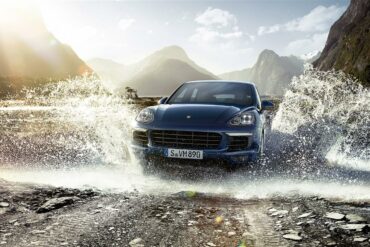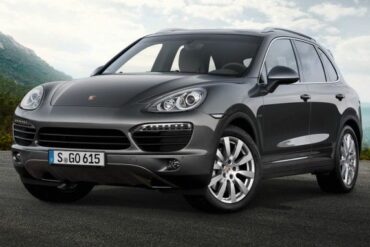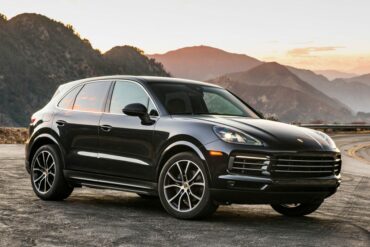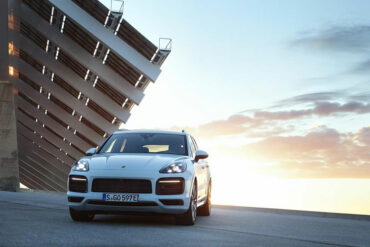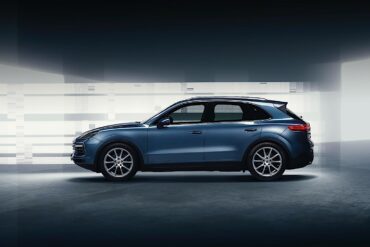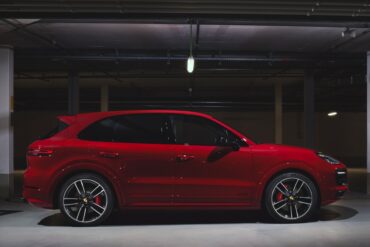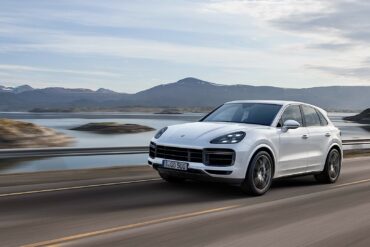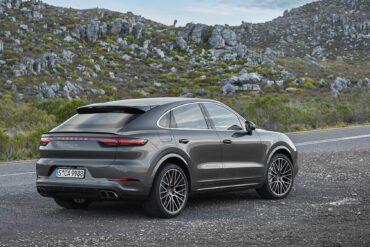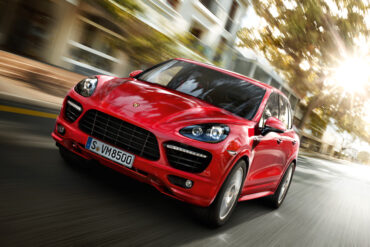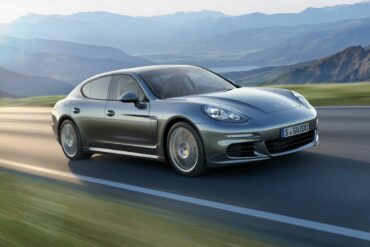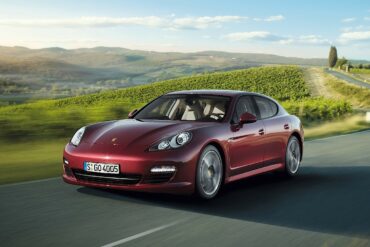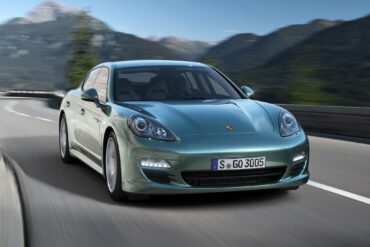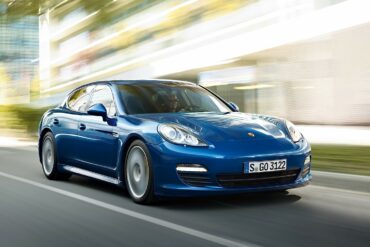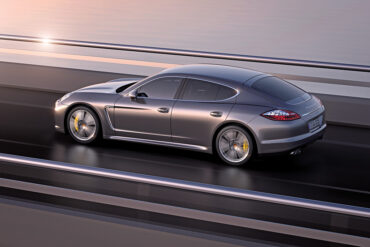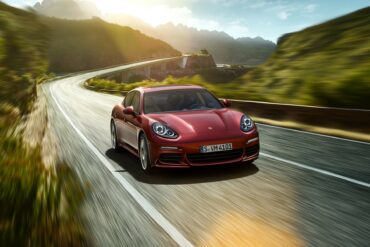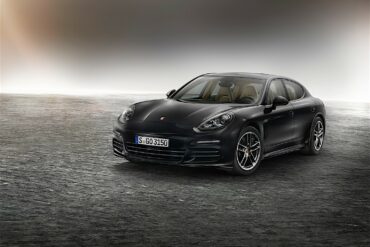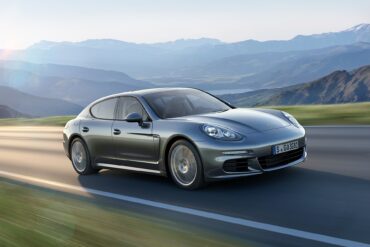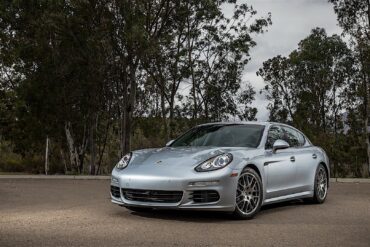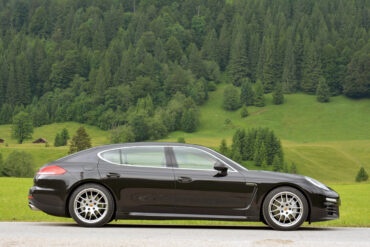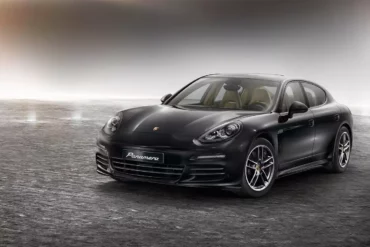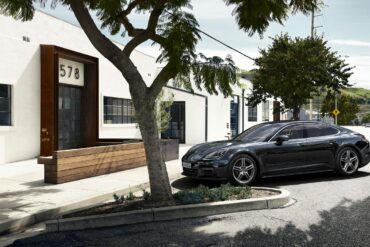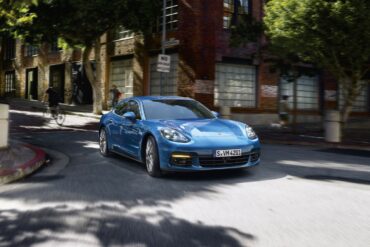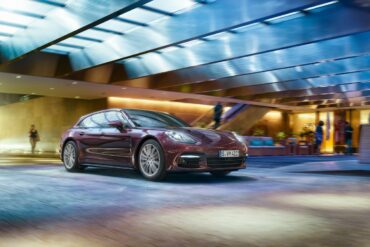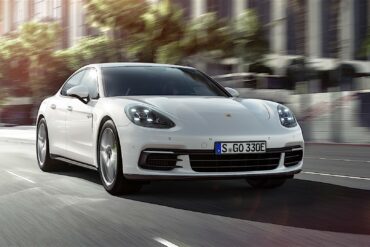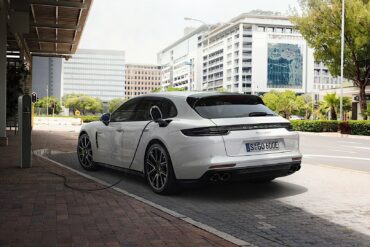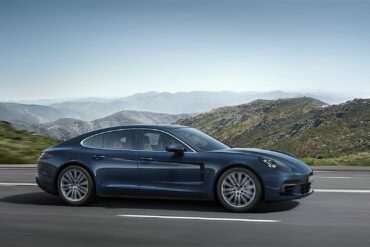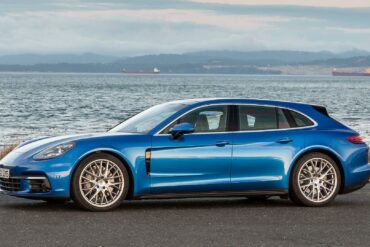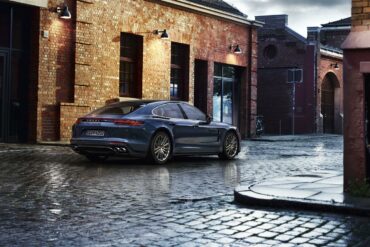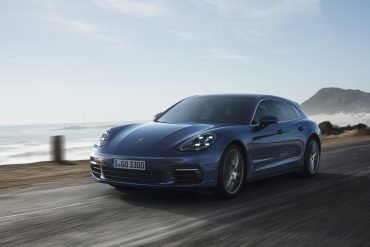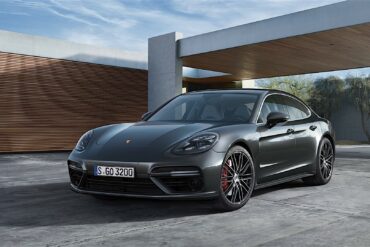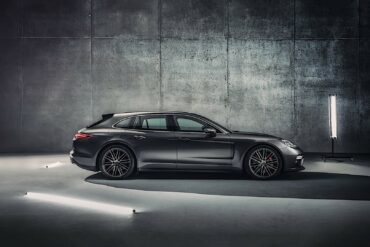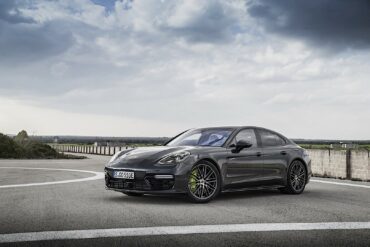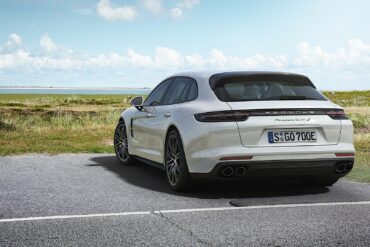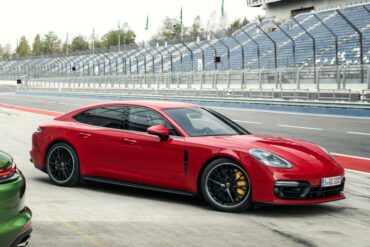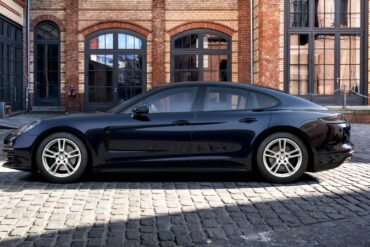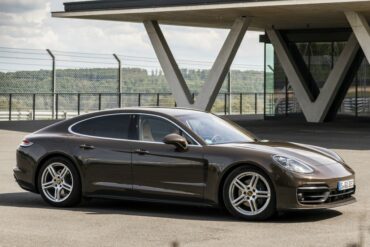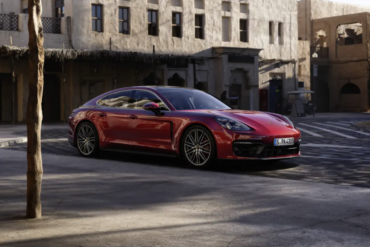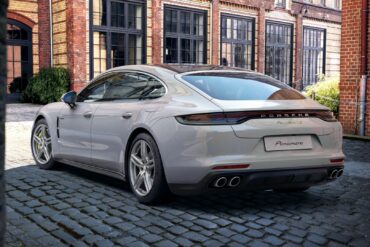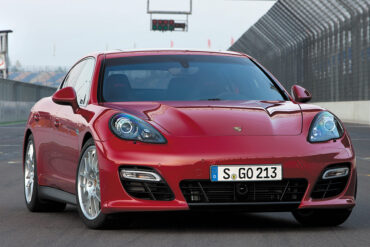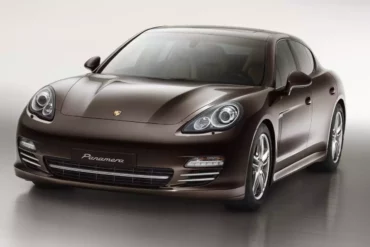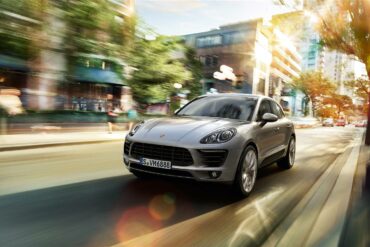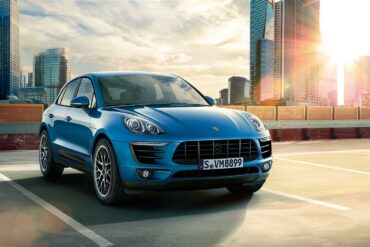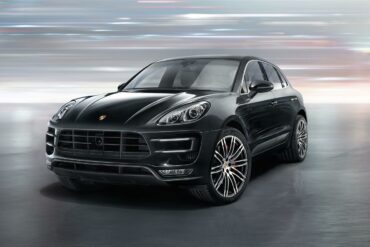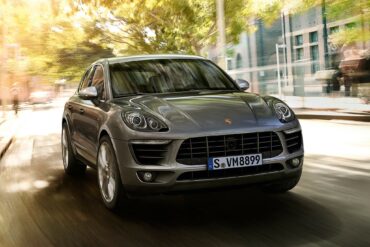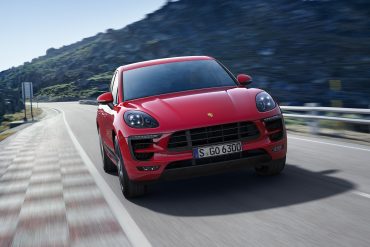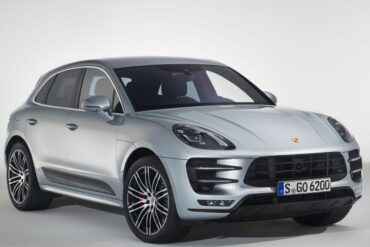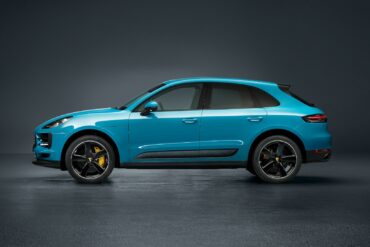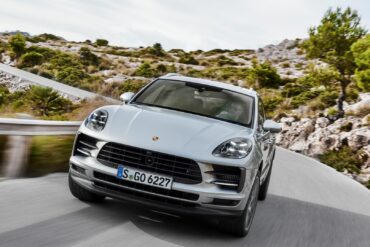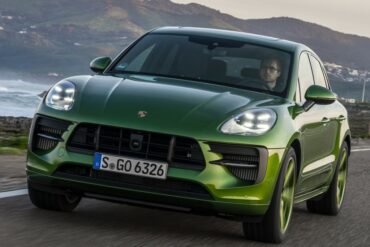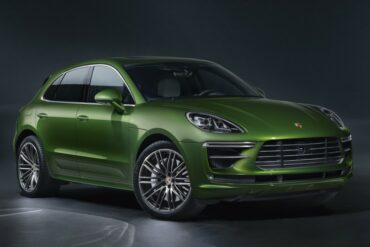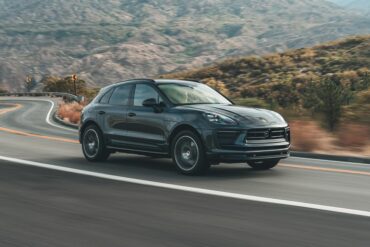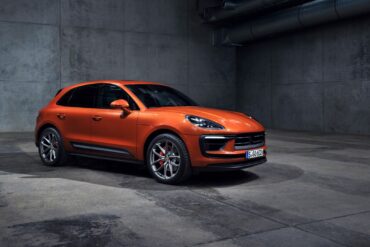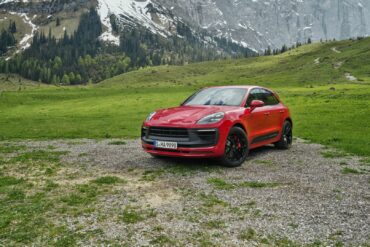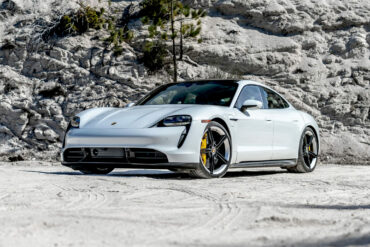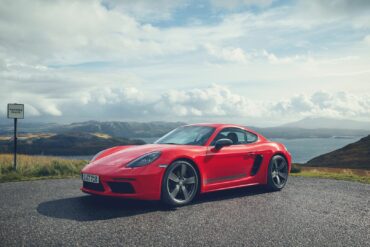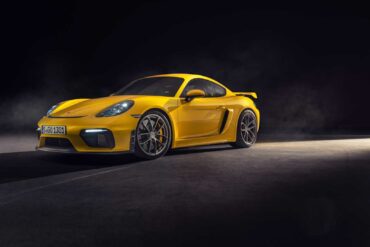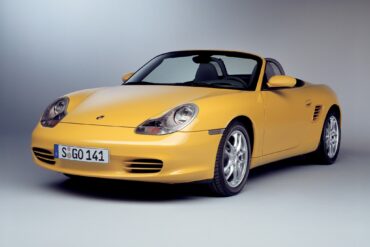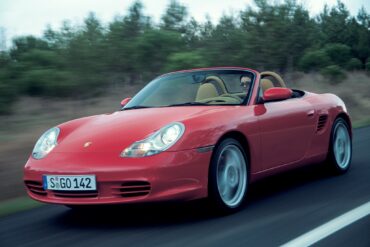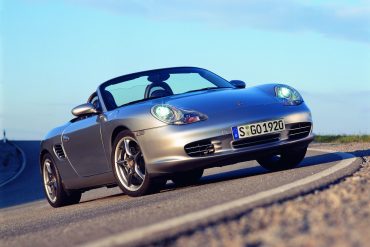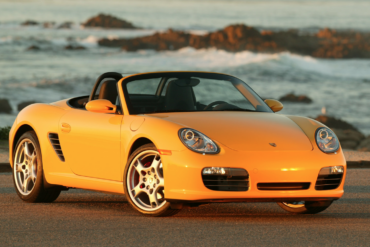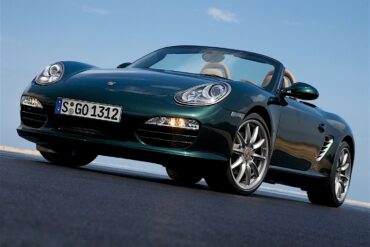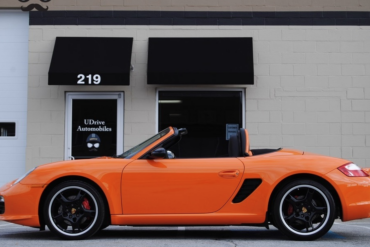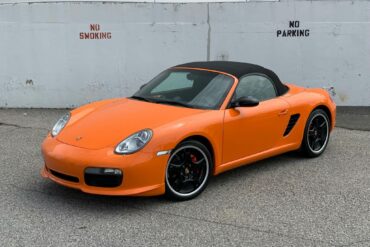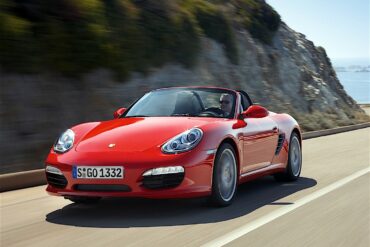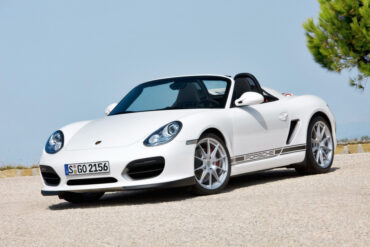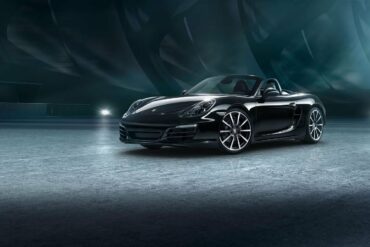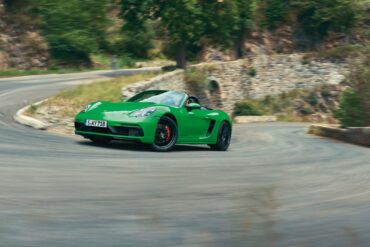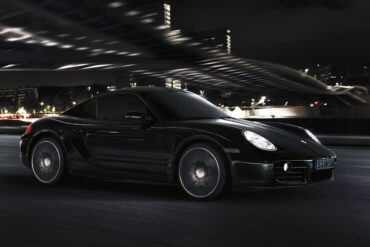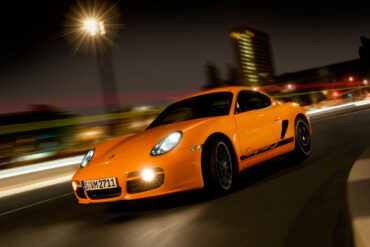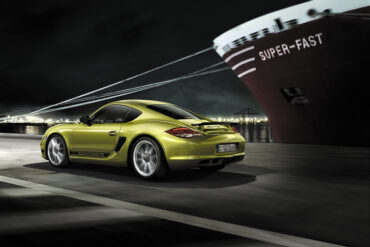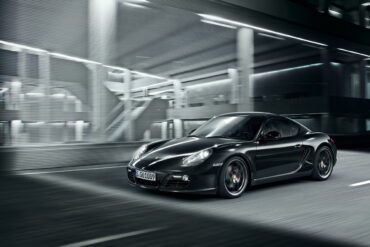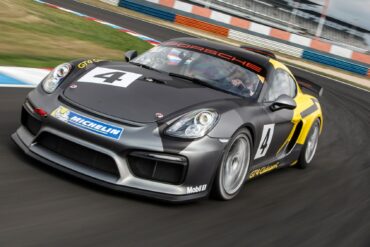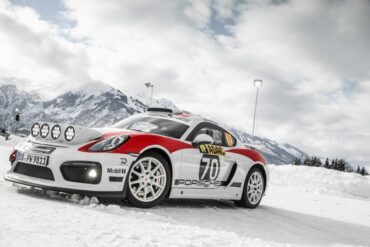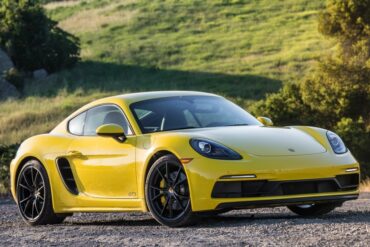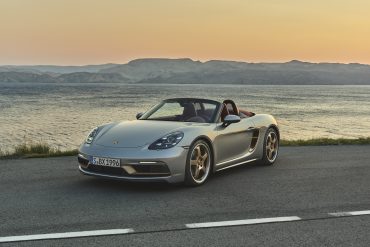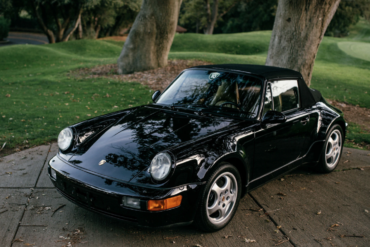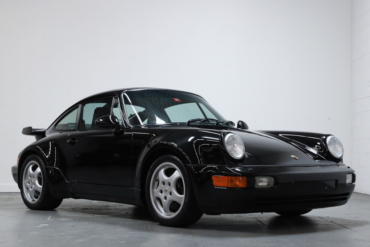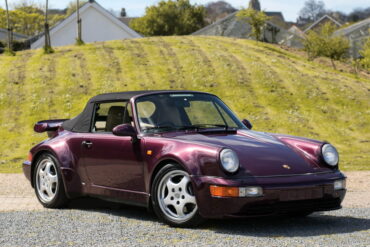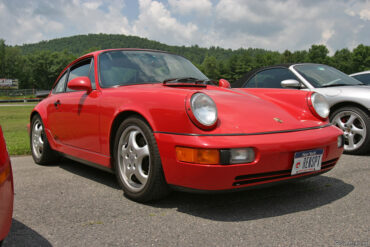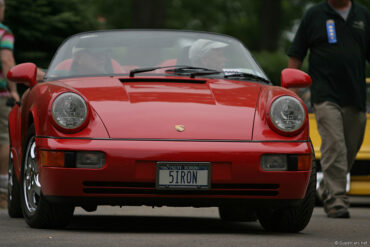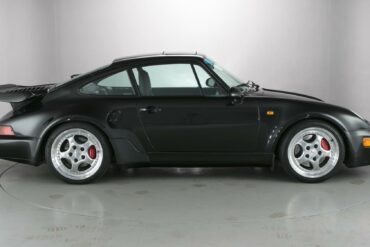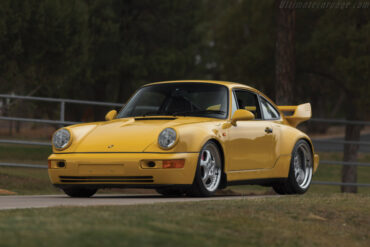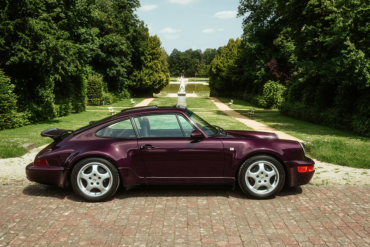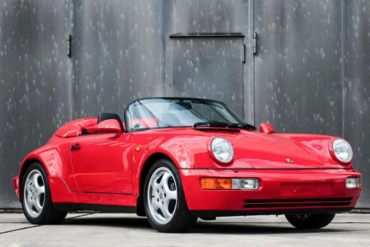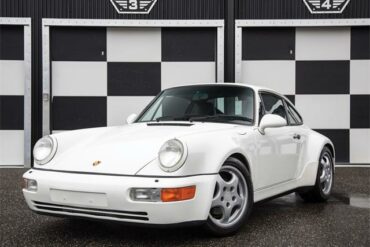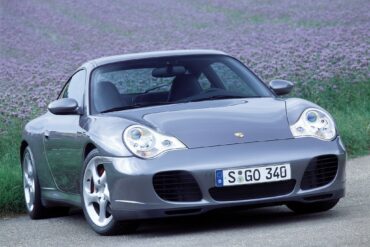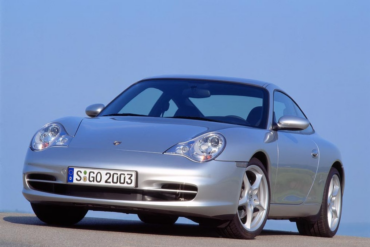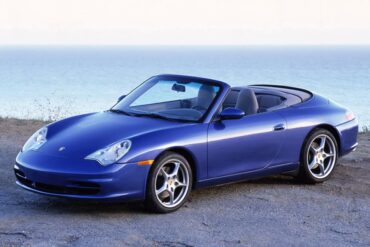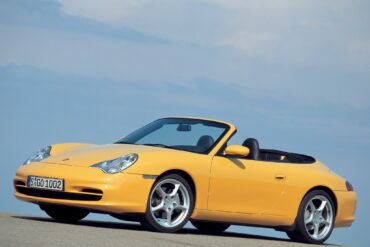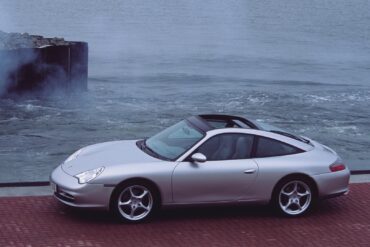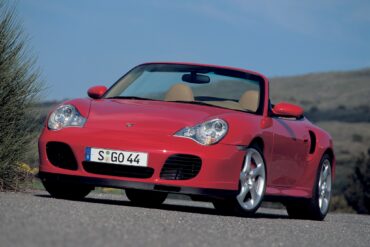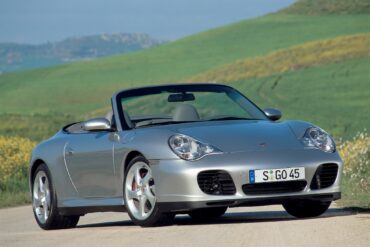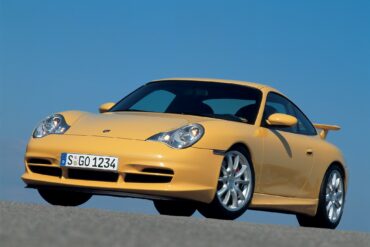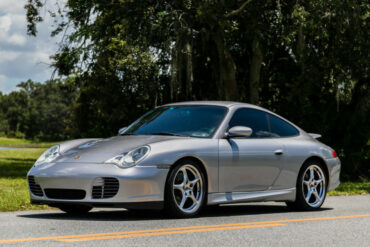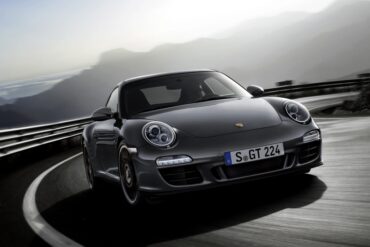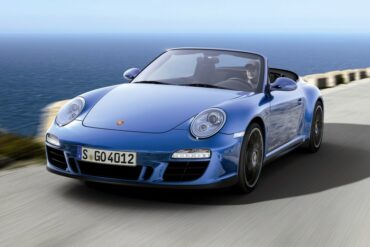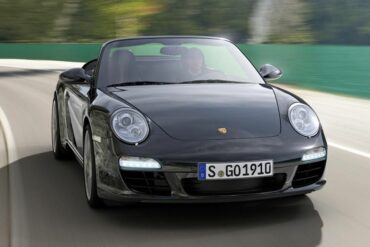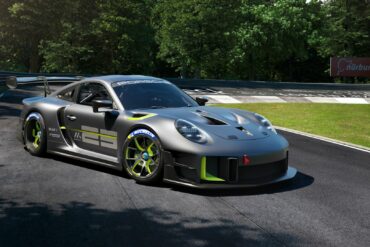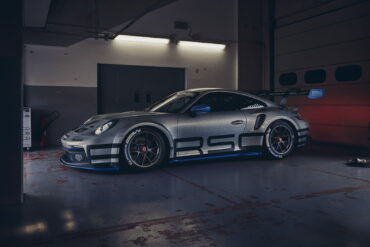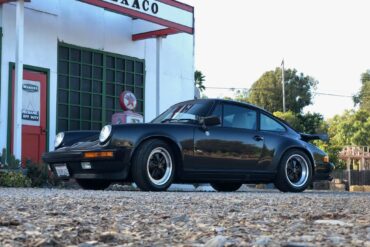The Cayenne S diesel earns the “S” by way of a twin-turbocharged 4.2-liter diesel V-8 engine that pumps out a prodigious 382 hp and 627 lb-ft of torque. By comparison, the non-S Cayenne diesel’s 3.0-liter V-6 spits out a relatively puny 240 hp and 406 lb-ft of twist. Interestingly, the S diesel gets Porsche’s engine stop-start system standard; here in the U.S., the fuel-saving feature isn’t available on the pedestrian Cayenne diesel.
The Cayenne S diesel earns the “S” by way of a twin-turbocharged 4.2-liter diesel V-8 engine that pumps out a prodigious 382 hp and 627 lb-ft of torque. By comparison, the non-S Cayenne diesel’s 3.0-liter V-6 spits out a relatively puny 240 hp and 406 lb-ft of twist. Interestingly, the S diesel gets Porsche’s engine stop-start system standard; here in the U.S., the fuel-saving feature isn’t available on the pedestrian Cayenne diesel.
The third generation of the Porsche Cayenne was unveiled in August 2017. The third generation Cayenne is built on a totally new platform, shared with SUVs like the Bentley Bentayga and Lamborghini Urus. It was fitted with important technical upgrades, such as the rear-axle steering system, which allowed a better cornering speed and an easier parking maneuver.
The E-Hybrid version of the current Cayenne came in 2018. Porsche used the same platform as the Bentley Bentayga and the Lamborghini Urus for the third generation of the Cayenne. This platform was designed from the beginning to accept a hybrid version. It also featured a rear-axle steering system which really helps with low speed turning and cornering at speed.
The 434-hp Cayenne S goes from 0 - 60 mph in just 4.2 seconds. Its twin-turbocharged 2.9-liter V-6 helps it to crush the quarter-mile in just 12.8 seconds. Perhaps even more impressive is that the on the optional 21-inch Pirelli P Zero summer tires, the Porsche has a 0.93 g of cornering grip. This is basically a sports car in an SUV body. The Cayenne's dynamic excellence is unmatched in the segment. Easily the best SUV on sale today.
The V8 is back in the Cayenne GTS after a break for the second generation (it got a twin-turbo V6). The Cayenne GTS is now also available in the new "Coupe" body style. A twin-turbocharged 4.0-liter V8 is good for 453 horsepower and 457 lb-ft of torque. Zero to 60 mph takes a claimed 4.2 seconds if the Sport Chrono package is fitted, and top speed rises to 168 mph. he only transmission available is an eight-speed automatic. This is one sweet ride.
Its top model was the Cayenne Turbo, with 550 hp under the hood. The third generation came to fix what its predecessor was criticized for: the exterior design. While the second generation featured some details that could remind of a Hyundai, the third generation was completely new from tip to toe. Under the hood, the Cayenne Turbo featured a 4.0-liter V8 unit with two turbochargers. It was mated as standard to an eight-speed automatic transmission.
Car and Driver said "It isn't really a coupe, but this 541-hp fastback SUV is the same awesome Cayenne Turbo underneath—with a sexier backside". We agree. Here's what you need to know. With its 541-hp twin-turbo 4.0-liter V-8, eight-speed automatic transmission, and all-wheel drive, the new fastback version of Porsche's largest SUV is mechanically identical to the conventional Cayenne Turbo SUV, and the two vehicles feel exactly the same from behind the wheel.
The Cayenne GTS is the hair-splitter’s latest achievement. It’s a Cayenne powered by the same 4.8-liter V-8 as seen in the Cayenne S but tuned for an additional 20 horsepower and 11 pound-feet of torque to make 420/380. It wears a body similar in style to the Cayenne Turbo, meaning a domed hood, blacked-out trim, and body-color fender extensions and side skirts. And it’s loaded with standard performance gear that is optional on lesser Cayennes. What isn't there to like?
The entry-level Panamera featured a 3.6-liter V6 engine carried-over from Audi. It was paired as standard to a 6-speed manual. A 7-speed PDK (dual-clutch) was on the options list. The base-model Panamera and Panamera 4 were introduced in 2010. While it came later than the initial variants, the base Panamera was no second class car. As a everyday passenger car it was plenty powerful with great luxury and plenty of standard features.
The Panamera 4 was the entry-level all-wheel-drive version for the Panamera, the long-waited four-door Porsche. The Panamera's headlights resembled those installed on the Cayenne. The profile resembled an elongated 911 or the 989 concept-car. On the front fenders, two vents were used to extract the air within the wheel-well and decrease the front-lift effect. In the back, the taillights resembled those found in the Cayman. In the back, on the trunk-lid, a retractable wing was installed. It was automatically extended at speeds over 120 kph (74.5 mph).
In May 2011, Porsche unveiled the diesel version for its four-door Panamera. With the introduction of that version, it switched from a road runner to a long cruiser luxury sports-sedan. Porsche didn't want to lose that market and decided to offer a diesel version for the Panamera. Since the car was designed for long travels, a diesel engine would give it a range of over 1200 km (746 miles). After the initial shock of its regular customers, soon the orders started to pick-up.
The Porsche Panamera S Hybrid marks the beginning of a new chapter of Porsche Intelligent Performance, continuing the success story of the four-door Gran Turismo. Not only is the new model the most economical Porsche of all time, it also outperforms by a mile all full hybrid production cars of its class, the luxury class, in terms of consumption and CO2 emissions. And at the same time, without any restrictions, it offers the sporty, exclusive character and custom comfort so typical of this unique Porsche Gran Turismo family.
The Turbo S featured the same 4.8-liter bi-turbo engine from the Turbo version, but with a new engine management system and improved turbochargers. The result was a 550 hp beast that could blast most of the supercars on the road with a 0-100 kph (0-62 mph) time of 3.8 seconds. It's all-wheel-drive and the Sport Chrono Package Turbo were standard features.
The 2014 Panamera lineup was given a great refresh. The base engine, installed in the Panamera 4 version, was an upgraded version of the previously used 3.6-liter V6. For the 2013 model year, it was mated exclusively with a 7-speed (PDK – dual-clutch) automatic gearbox and the 6-speed manual was dropped. It also gained some extra horses. The power of the V6 engine in the Panamera increased ten hp (eight kW) to 306 bhp @ 6200 rpm and 295 ft lbs @ 3750 rpm of torque.
The Panamera received a fairly substantial mid-cycle update for 2014. The base engine, installed in the Panamera version, was an upgraded version of the previously used 3.6-liter V6. For the 2014 model year, it was mated exclusively with a 7-speed (PDK – dual-clutch) automatic gearbox and the 6-speed manual was dropped. It also gained some extra horses. The power of the V6 engine in the Panamera increased ten hp (eight kW) to 306 bhp @ 6200 rpm and 295 ft lbs @ 3750 rpm of torque.
The big focus for the Panamera Diesel update was around the engine. It got a completely new 300-bhp engine and dynamic performance package. Power output was up by 50 bhp (around 20% increase) with performance improved across the spectrum. Acceleration from 0 - 60 mph is now 6.0 seconds, while the top speed has increased to 178 mph. In addition to the improved power output, dynamic performance was also optimized: For instance, the Porsche Panamera Diesel now features the controlled rear-axle differential lock with Porsche Torque Vectoring Plus (PTV+) as standard for the first time.
The biggest change for the 2013 Panamera S was under the hood, where a twin-turbo 3.0-liter V6 engine was installed. It replaced the older 4.8-liter naturally aspirated unit. It was a win-win combination since it offered 20 hp more and it was more fuel-efficient. Unlike its predecessor, it was available exclusively with a 7-speed automatic (PDK – dual-clutch). Overall, a great update and almost the perfect passenger car.
As part of the mid-cycle Panamera refresh, Porsche introduced two "Executive" models. The Panamera 4S Executive and the Panamera Turbo Executive. These variants had especially high standards for space, ambience and ride comfort. The wheelbase and passenger compartment were extended by 15 centimetres, and both of these dimensions directly benefit comfort in the rear seating area, since the body was extended behind the B pillar in the long version.
For the 2016 model year, Porsche has added a new version of the Panamera that it has dubbed the “Edition.” Despite its weird name, the Panamera Edition adds a lot of value at a price that is only slightly north of the base model’s MSRP.
Porsche launched the second generation Panamera for the 2017 model year. The updates were meaningful. The Panamera finally looked great, with a wider, lower, sleeker design that fixed all the hunchback look of the old design. Complementing the fresh threads is a completely reimagined interior, replete with touch-capacitive surfaces and massive display screens. The base Panamera got a 3.0-liter, turbo V-6 with 325 bhp and 332 ft lbs. Takes only 5.6 seconds to hit 60 mph and has a respectable 163 mph top speed.
The Panamera finally looked great, with a wider, lower, sleeker design that fixed all the hunchback look of the old design. Porsche launched the second generation Panamera for the 2017 model year. Complementing the fresh threads is a completely reimagined interior, replete with touch-capacitive surfaces and massive display screens. The Panamera 4 got a 3.0-liter, turbocharged V-6 with 325 bhp @ 5400 rpm and 332 ft lbs @ 1800 rpm. Performance was impressive, taking only 5.6 seconds to hit 60 mph and a respectable 163 mph top speed.
Porsche expanded the Panamera family with the addition of a new body version: The Porsche Panamera Sport Turismo. The Panamera 4 got the Sport Turismo treatment. The Panamera 4 Sport Turismos gets the same all-wheel drive system and underlying mechanicals. That means, it gets the base Panamera's 330-hp turbocharged 3.0-liter V-6. Porsche doesn't call the Sport Turismo a station wagon, but that's kinda sorta what it is.
The fourth model of the Panamera was introduced at the 2016 Paris Motor Show. It was the enhanced plug-in hybrid version, named 4 E-Hybrid. It was the first all-wheel-drive Panamera hybrid. It was fitted with a more powerful electric motor and a twin-turbo 2.9-liter V6 gasoline engine. The powerplant was fitted to an 8-speed automatic gearbox. Its predecessors were fitted with rear-wheel-drive only. The Panamera 4 E-hybrid always started in electric mode and turned on its gasoline unit later.
This is one practical family car with very green credentials and incredible performance. The Porsche Panamera 4 E-Hybrid was the first all-wheel-drive Panamera hybrid and in Sport Turismo body style it is more practical and dare we say it looks better too. Just like the coupé-style Porsche Panamera sports saloon, the Sport Turismo is characterized by its very dynamic proportions, which also allow it to feature three full rear seats.
The second generation of the Panamera was introduced as a 2017 model year car and the full suite of variants was available straight out of the gates. They all got a visual update and lots of improvements across the board. The Panamera 4S featured 19” light-alloy wheels and only two colors as standard: black and white as standard. The engine was a new 2.9 L twin-turbo V6 which was good for 434 bhp @ 5650 rpm and 406 ft lbs @ 1750 rpm of torque.
The 2017 Panamera 4S Sport Tourismo was more like a shooting-brake than a station-wagon. More like a lowered Macan than a station-wagon Panamera. Its raked rear looked like it was there to enhance the aerodynamic rather than increase the cargo area. For the powertrain, the 4s Sport Tourismo featured a twin-turbo V6 engine mated to an 8-speed automatic transmission and an all-wheel-drive system.
In the Panamera 4S Diesel, a V8 with 310 kW/422 hp generates powerful thrust and a maximum torque of 850 Nm. And our friends in Europe love that kind of power in a sports sedan, which is why Porsche built this car for them. Add some all-wheel-drive security and Diesel mileage, and the Panamera 4S Diesel may be the ultimate cross-continent cruiser.
In 2017, at the Geneva Motor Show, Porsche introduced the Sport Tourismo version. It is like a station wagon but has the look of a Shooting Brake. With this design, the Panamera is further away from the 911 rear design. A larger trunk means more space for luggage and golf bags. If the rear seats are folded, the total trunk space can reach 1390 liters (49 cu-ft). In 2017, Porsche installed a V8-diesel engine in the Panamera Sport Tourismo.
The Panamera Turbo was the best balance between performance, luxury, and comfort. The new, 4.0-liter twin-turbo engine offered 30 hp more than its predecessor, despite having a smaller displacement. The PASM (Porsche Adaptive Suspension Management) was fitted as an option and so was the Porsche Chrono Package. It was fitted as standard with a 7-speed (PDK – dual-clutch) automatic transmission which sent its torque in all corners via PTM (Porsche Traction Management) system.
The Porsche Panamera Turbo also got the Sport Turismo body option in 2018. It is a practical five-seater with lots of room, a great design and stonking performance.It got all the same powerful petrol engine as the sedan version of the Panamera Turbo. Its 4.0-litre biturbo V8 develops 404 kW / 550 hp (at 5,750 rpm) and a maximum torque of 770 Nm (between 1,960 and 4,500 rpm). It has 30 hp more power than the previous model and accelerates to 100 km/h in 3.6 seconds.
By combining a Porsche Panamera Turbo with the hybrid system already developed for the 4 E-Hybrid, the result is pretty epic. The new Porsche Panamera Turbo S E-Hybrid sees the sportscar manufacturer launch a plug-in hybrid model as the flagship of a model line for the first time. The four-litre V8 engine from the Panamera Turbo is combined with an electric motor, resulting in 500 kW/680 hp of system power and outstanding power delivery: Even when just above idle speed, the Panamera Turbo S E-Hybrid offers an 850 Nm of torque. How about 3.4 seconds 0 - 60 mph time???
By combining a Porsche Panamera Turbo with the hybrid system already developed for the 4 E-Hybrid, the result is pretty epic. The new Porsche Panamera Turbo S E-Hybrid sees the sportscar manufacturer launch a plug-in hybrid model as the flagship of a model line for the first time. The four-litre V8 engine from the Panamera Turbo is combined with an electric motor, resulting in 500 kW/680 hp of system power and outstanding power delivery: Even when just above idle speed, the Panamera Turbo S E-Hybrid offers an 850 Nm of torque. How about 3.4 seconds 0 - 60 mph time???
The current 971 generation Porsche Panamera is the latest model from the German marque to receive their always much anticipated, GTS treatment. For the 2019 model year, the second-gen Panamera is now a beneficiary of the badge - which actually stands for ‘Gran Turismo Sport’ - that has come to represent the pragmatist’s choice of Porsche automobile. The Panamera GTS is also now available in a long-roof wagon body style, dubbed the Sport Turismo. The Porsche Panamera GTS Sport Turismo does not have its own unique power plant, but is the beneficiary of a detuned Panamera Turbo engine instead.
For the 2021 model year, the Panamera featured a redesigned front fascia, with a different bumper and lower apron. The previously optional Sport Design front end was featured as standard on the facelifted version. In the back, the revamped light strip ran seamlessly over the trunk lid, with an adapted contour and new LED taillights were installed. The three-piece retractable wing was kept.
Under the hood, the Porsche Panamera 4 featured a twin-turbo V6 engine, good for 330 hp. It was carried-over from the non-facelifted version. The 7-speed PDK (dual-clutch) automatic transmission was fitted as standard. For the 2021 model year, the Panamera 4 featured a redesigned front fascia, with a different bumper and lower apron. The previously optional Sport Design front end was featured as standard on the facelifted version.
The Executive version of the Porsche Panamera 4 gives you all the extra space with all the same goodness of the twin-turbo V6 engine and its 330 hp of performance. The 7-speed PDK (dual-clutch) automatic transmission was fitted as standard. For the 2021 model year, the Panamera 4 featured a redesigned front fascia, with a different bumper and lower apron. The previously optional Sport Design front end was featured as standard on the facelifted version.
As implied by the 'Executive' designation, this Panamera is tailored to those who love spending time in the rear compartment. It is about 15 cm longer than the standard Panamera 4S E-Hybrid, with most of the extra length dedicated to giving rear passengers more room. Asides from the elongated wheelbase, there's not much to distinguish between the two Panamera 4S E-hybrid models.
The Panamera GTS was more like a detuned Turbo than an upgraded 4S. Its outside look was on a par with the Panamera Turbo, with large air intakes on the front and standard front section from the SportDesign package, that emphasized the sporty dynamics. On the front, the bi-xenon headlights had black inner bezels and featured four LED daytime running lights. In the rear, there was the same adaptive spoiler that deployed at speeds above 205 kph (121 mph).
Based as they are on the 300-hp V-6 Panamera and Panamera 4, the Platinum Edition is available with either rear- or all-wheel drive. Outside, the cars are separated from standard V-6 Panameras by platinum silver metallic trim. The shiny stuff covers the grille and rear diffuser accents, the lower half of the side mirrors, and the trunk trim. Porsche also throws in a set of 19-inch Turbo wheels and finishes the window trim in gloss black. A sport design steering wheel is standard, as well as Porsche crests on the front and rear headrests and “Platinum Edition” lettering on the doorsill trim.
Porsche subsequently released a base Macan for select Asian markets and the United Kingdom. Using a reworked version of the Volkswagen Group's 2.0-litre inline-four EA888 Gen 3 engine used in multiple applications such as the Audi Q5. This engine became offered globally for the Macan's 2017 model year following an announcement in March 2016
The Macan S was part of the initial Macan launch and it was equipped with a 3.0-liter V6 twin turbo engine delivering 335 hp and also features an active all-wheel-drive system with an electronically controlled, map-controlled multi-plate clutch. This AWD system is fitted on all Macan models. A seven-speed double-clutch transmission is the only transmission on offer.
The top model in the Porsche Macan lineup is the Macan Turbo. It launched in 2016 as the most powerful vehicle in the competitive compact SUV segment and its 3.6 liter twin-turbo V6 engine is a real gem. Good for 395 bhp @ 6000 rpm and torque of 406 ft lbs @ 1350 rpm, it helps the Macan Turbo accelerate from 0 to 60 mph in just 4.50 seconds (with the Sport Chrono package fitted) on its way to a top speed of 165 mph.
Porsche’s oil burner variant is a fairly irresistible redo of Audi’s architecture. Aside from the compact size, there is no obvious visual connection to the Q5. Porsche’s designers went to work inside and out. The Macan S Diesel is the economical long-distance runner of the three Macan models. Its 3.0-litre, six-cylinder V-engine has tons of torque and lots of range.
For the 2017 model year, Porsche added the Macan GTS trim to the lineup. The new Macan GTS gets a higher-output version of the twin-turbo V-6 that powers the S model. It also gets tweaked performance-oriented chassis, unique design elements and additional standard equipment. The 2.9-liter twin-turbo V6 engine delivers 355 bhp @ 6000 rpm and 369 ft lbs of torque from 1650 rpm. Combined with the newly adapted PDK dual-clutch transmission, the Macan GTS can accelerate from zero to 60 mph in 4.4 seconds.
The top model in the Porsche Macan lineup is the Macan Turbo and in 2017 Porsche made it extra special by offering a Performance Package add on. After the performance enhancement, the twin-turbocharged, 3.6-litre V6 engine delivers 324 kW (440 hp; combined fuel consumption 9.7–9.4 l/100 km; CO2 emissions 224–217 g/km). With 30 kW (40 hp) more than the Macan Turbo, this figure places this variant firmly in the top spot in this model line. The car now accelerates from zero to 100 km/h in just 4.4 seconds
In July 2018, Porsche unveiled a new facelift for the Macan range in Shanghai. The production started the following month and the Europeans saw it at the Paris Motor Show in September. The 2019 Porsche Macan update includes refreshed exterior styling that includes updated front and rear bumpers, new taillamps that span the width of the liftgate, and new wheel designs. The base Macan receives a 248-hp turbocharged four-cylinder.
The Macan has important upgrades for the 2019 model, featuring new and improved front lights with LED headlights as standard and three-dimensional LED lights in the rear. The new model features a 3.0-liter turbocharged V6 engine generating 348 horsepower and 354 lb-ft of torque. The new and more powerful engine marks an increase in both horsepower and torque over the prior Macan S models. 0 to 60 mph in 4.9 seconds with the optional Sport Chrono and top speed is 157 mph.
The GTS returned to the lineup for 2020 after a year off. Its twin-turbo 2.9-liter V-6 makes 375 horsepower and 383 lb-ft of torque. Quickness is important in a crossover with sporting intentions, but we love the way the GTS handles and acts like a true sportscar. Apple CarPlay, available as part of the Premium package or as a standalone option, gains wireless connectivity, while wireless device charging has been added to the designated Smartphone Compartment option.
After a one-year hiatus, Porsche brings us a Macan Turbo with more power, more speed, and more standard equipment. It swapped its twin-turbocharged 3.6-liter V-6 for a new twin-turbo 2.9-liter V-6 shared with versions of the larger Cayenne SUV and the Panamera. Porsche claims that it's enough to punt the all-wheel-drive Macan Turbo to 60 mph 0.3 second quicker than before. This is the top of the Macan lineup heap.
Porsche introduced yet another facelift for the Macan lineup for the 2022 model year. The range got more power under the hood, a refreshed design, and an improved interior. The base turbocharged 2.0-liter four-cylinder now makes 261 horsepower. It is a newly developed, turbocharged four-cylinder engine that helps hustle the base Macan from 0 - 60 mph in just 6.2 seconds and reaches a top speed of 144 mph. The redesign on the outside gives the base 2022 Macan a tighter look.
Front fascia with newly designed spoiler. The characteristic Macan side blades in new designs. The redesigned rear fascia and diffuser. Revised steering wheel options. The base turbocharged 2.0-liter four-cylinder now makes 261 horsepower. Standard features include a 10.9-inch touchscreen infotainment system, a 10-speaker audio system, and LED headlights.
The 2022 GTS get the same engine that powered last year's Turbo model, a twin-turbocharged 2.9-liter V-6 rated for 434 horsepower and 405 lb-ft of torque, which amount to increases of 59 horses and 22 lb-ft over the previous GTS. All Macans also come standard with a seven-speed dual-clutch automatic transmission and all-wheel drive, which combine to push the GTS into the "genuinely fun" category of athleticism and should help it mimic the Turbo's 3.5-second sprint to 60 mph.
The Porsche Taycan Turbo S is pumping out 750hp and 774lb-ft tq from 93 kwH battery and 2 electric motors. The Turbo S is clocked at a super-fast 2.6 seconds for the 0-60 mph. The performance is mind-bogglingly quick and it is utterly relentless at any speed. But most impressive is just how the Taycan Turbo S drives through the bends, how it feels when moving going quickly. It feels like a Porsche. On the inside, it is modern, luxurious and feels like the future. We love everything about the Taycan Turbo S except the price. It ain't cheap.
Similar to the 911 T, the 718 Cayman T is not the fastest, most luxurious or even the cheapest of all the 718 variants. However, the car is a unique combination of features and nuances that add up to more than the sum of its parts. The T-wins are the perfect car for somebody who knows exactly what they want, and wants nothing more than that - the purist’s car. The Cayman T is equipped with the base-model 718’s mid-mounted 2.0L flat-four turbocharged engine, which produces 296 bhp @ 6500 rpm and 280 ft lbs of torque. The Sport Chrono package is included as standard.
The 718 Porsche Cayman GT4 is everything you could possibly want in a sports car. The sublime combination of a legendary chassis and naturally aspirated 6-cylinder Porsche engine is accentuated by the emphasis that less is more when done right - and nobody does this better than Porsche’s GT division. No one will make the argument that these are objectively inexpensive cars, but for those in the market for an introductory dose of supercar sensory-overload, the GT4 checks all the boxes, and then some. Need a track car and daily driver in one package? Then the 718 Cayman GT4 may be the car for you. An absolute blast.
The first generation Boxster got a facelift and refresh for the 2003 model year. The 2003 Boxster came on the market with new engines and new options. It also had a new face, but not that different than the first generation. The result was more horsepower, the 2.7 liter now good for 225 bhp @ 6300 rpm and 192 ft lbs @ 4750 rpm. Power was up by 8 horsepower over the prior year model, while torque was unchanged. From the outside, the 2002 Boxster featured an apron with two air-intakes on the sides.
The Boxster S was revised along with its Boxster version in 2003. From the outside, the 2002 Boxster S featured an apron with three air-intakes, one more than the non-S version. The 3.2-liter unit was installed in the Boxster since 2000, but after the facelift it was improved by 10 hp, reaching 258 hp. It was paired as standard with a 6-speed manual, or a 5-speed Tiptronic (automatic) as an option. As expected, the manual version was quicker and faster.
In 2004, the Boxster S Special Edition, also called 550 Spyder Boxster S Special Edition was introduced with a production run of just 1,953 cars (paying homage to the 550 Spyder's year of introduction). 500 cars were made for the US Market. These were all painted in GT Silver Metallic, the same colour as the Carrera GT concept presented in 2000, and had unique cocoa-brown full-leather interior as standard with grey natural leather as a no-cost option.
For the 2007 model year, the base Boxster received a revised engine featuring VarioCam Plus to provide a 3.7 kW (5.0 hp) power increase (183 kW (245 hp) the same as the Cayman). The Boxster S' engine was upgraded from 3.2-litre to 3.4-litre, resulting in a power increase of 11 kW (15 hp) more (220 kW (295 hp) the same as the Cayman S). These upgrades made the Boxster series and the Cayman series equivalent in terms of power.
In 2008, the second generation of the Boxster received new technologies and more power. It reached almost the same power as the former Boxster S, from the first generation. The 2.9-liter unit replaced the older 2.7-liter engine and offered 10 hp more than the older engine. It was paired as standard to a 6-speed manual, and a 7-speed PDK (Porsche dual-clutch) automatic was available as an option. The outside gets some welcome design tweaks also, while on the inside we get some updates and more technology options.
Porsche unveiled its 2008 Limited Edition Boxster and Boxster S models at a private gathering at the occasion of the 2007 New York Auto Show. Largely inspired by the 2007 911 GT3 RS, only 250 examples of each model were produced in brilliant orange. Other special exterior features included glossy black painted mirrors, alloy wheels, front and side air inlets, and model designation.
Porsche gave us something special in 2008, the Limited Edition Boxster and Boxster S. Pricing started at $59,900 for the Boxster S version. The Limited Edition’s bright orange paint was previously featured on the race-ready Porsche 911 GT3 RS. The Limited Edition is equipped with a sport exhaust system, and safety bars (also painted orange). The SportDesign package is also included.
The 2008 facelift of the Boxster S is powered by a new direct-injection 3.4-liter Boxer engine which develops more power than the earlier variant. The styling got a bit updated with some redesigned headlight casings, taillights, and bumpers, while the interior got new infotainment and more material/color combinations. There's a revised 6-speed manual as well as a new 7-speed PDK gearbox. Performance improves, with power now at 310 hp, rocketing the 987.2 Boxster S from 0 - 60 mph in just 5.2 seconds and to a top speed of 170 mph.
On 5 November 2009, Porsche officially announced the Boxster Spyder, which was the lightest Porsche on the market at the time, weighing 1,275 kg , 80 kg lighter than a Boxster S. This was achieved through the elimination of the conventional soft top's operating mechanism, the radio/PCM unit, door handles, air conditioning, storage compartments, cup holders and large LED light modules on the front fascia, although some of these could be re-added to the car in the form of options. Weight saving was also gained using aluminum doors, an aluminum rear deck and the lightest 19-inch wheels.
The mid-engine roadster is powered by the 2.7 liter flat-six engine with 265 hp. Its color concept remains consistent with the soft top and supplemental safety bar which are both finished in black. The wind deflector reduces undesirable turbulence when the soft top is down. 20-inch Carrera Classic wheels and the Bi-Xenon™ headlights with Porsche Dynamic Light System (PDLS) set distinctive highlights, while standard two-zone air conditioning and heated seats provide a higher level of comfort for both driver and passenger. The Porsche Communication Management system is included as standard.
Essentially a liaison Boxster version situated between the 718 Boxster GTS and the hardcore 718 Spyder, the Porsche 718 Boxster GTS 4.0 offers a mix between the comfort and features found on the regular GTS and a detuned version of the engine found in the Spyder. Alongside its hardtop Cayman sibling, it is also one of the last production sports cars with a large displacement engine that doesn't feature turbocharging or supercharging. It produces 395 bhp @ 7800 rpm and 310 ft lbs @ 5000 rpm and can hit zero to 60 mph in 4.3 seconds (only 0.1 seconds slower than the Spyder).
In the middle of 2008, Porsche introduced the limited edition Cayman Design Edition 1. The Design Edition 1, also know as the DE1, was a Cayman S packaged with many exclusive cosmetic options intended to commemorate the 35th anniversary of Porsche Design. This car was clearly designed for the Porsche enthusiasts who wanted to own a very special Cayman. Buyers of the DE1 received a special briefcase that contained some pretty cool Porsche Design merchandise, including a Design Edition Chronograph Wrist Watch, Sun Glasses, Ballpoint Pen, Pocket Knife, Key Chain and the key to the DE1.
In late 2008, Porsche introduced the limited edition Cayman S Sport. The Sport was a Cayman S packaged with many sport options to create an edgy/sporty Cayman S. Beyond sport options, the Cayman S Sport received new DME software maps created to work with the Porsche Sport Exhaust and a unique Twin Chamber Dual Output Tailpipe that supply the Cayman S Sport with 303 horsepower at 6,250 RPM, making it the first Cayman to break the 300 horsepower ceiling.
On November 17th - 2010, Porsche CEO Matthias Mueller unveiled the 2012 Cayman R to an excited audience at the Los Angeles International Auto Show. Porsche pretty much threw the kitchen sink at this one, applying all they know and have available without actually redesigning the car. Every performance option on the list, and then some that weren't on the list have found their way into the Cayman R. A weight savings of 121 lbs. (55 kg) was achieved and it transformed the Cayman. We are going out on a limb here, but we think the Cayman R may be one of the best Porsche cars ever made.
The Limited Edition Cayman S Black combines many of the high performance benefits found only in the 2012 Cayman R with many other desirable options off the list, options that when combined create a distinct personality for this special car. After the R hit the scene, many potential buyers complained of the inability to order one with many of the highly desirable street options, particularly PASM. The Cayman S Black Edition gets the 330 BHP engine found in the R but without all of the other performance focus.
In 2015, Porsche announced the car we all thought Porsche would never build. It has been a few years since it has been released and the excitement It was the first time Porsche introduced lets the motorsports guys in Weissach sprinkle their magic on a Cayman. With components sourced from the 911 GT3, an engine carried over from a Carrera S and a tweaked and tuned chassis, brakes and aerodynamics, Porsche’s engineers did their best to produce the perfect mid-engine sports car for road and track use.
For testing purposes Porsche Motorsport built a few tarmac rally cars based on the Cayman 981 GT4 racing version. The Cayman rally car was the course car for the WRC (World Rally Championship) 2018 ADAC Rallye Deutschland. The FIA R-GT Cup was contested on tarmac rounds of the ERC and WRC, like the German WRC event. For Porsche, the entry of a concept study based on the near-production GT circuit race car was a critical test under real conditions.
The 2021 Cayman GTS 4.0 is the perfect car. The old GTS used a 2.5-liter turbocharged flat-4, and while it was a perfectly strong engine with lots of low-end torque, it lacked the personality and linear power delivery of a free-breathing flat-six. It didn't sound half as good, either. The GTS 4.0 was built to offer more performance and more grunt as well as a more aggressive design and all the good options included as standard. The new 4.0-liter engine is borrowed from the 718 Spyder and Cayman GT4, detuned to produce 394 horsepower and 309 pound-feet of torque. A 6-speed manual is standard.
Stuttgart. Porsche is celebrating the 25th birthday of its roadster family with a special anniversary model: the Boxster 25 Years. The limited edition is restricted to 1,250 units worldwide and is based on the GTS 4.0 model, which is powered by a 4.0-litre six-cylinder boxer engine with 294 kW (400 PS). It makes reference to numerous design features of the Boxster concept car that heralded the success story of the open-top two-seater at the 1993 Detroit Motor Show. The production version was launched in 1996 with hardly any changes in its visual appearance and is now in its fourth generation.
The American Roadster is essentially a turbo-bodied Carrera Cabriolet with Turbo suspension and brakes. Like the 356 America Roadster it was named after, the Type 964 America Roadster was a limited-edition, driver-focused convertible destined for the American market. Production for the America Roadster was limited at only 250 examples, and the model was only produced in 1992 and 1993. Its engine was a standard unit making 250 horsepower, but the special edition had the wide fender flares, suspension, brakes, and 17-inch Porsche Cup wheels of the 911 Turbo.
A forgotten part of the 964s history is the Turbo S2. It was built to adhere to homologation rules so Porsche could participate in IMSA's sports car racing series. IMSA's homologation rules meant that Porsche had to build at least 200 road-going versions of the participating car, 20 of which needed to share most of the primary components of the race car. The 911 Turbo S2 was built specifically for this purpose and exclusively for the United States and Canada. The 20 homologation specials left the factory as stock 964 Turbos, heading immediately to California-based tuner for "S2" engine upgrades.
The Turbo-look Porsche 964 has always been a very desirable automobile, among them 1,532 Carrera 2 Cabriolets constructed worldwide. Within that group, there were some cars that were even more specialized. The Register says six Turbo-look cabriolets were pulled off the production line in Zuffenhausen and transported to the Porsche Exclusive shop in Weissach. Three of these six powerful and luxuriously equipped drop-tops were equipped with left-hand drive for buyers in Germany (Code C00), and the other three were fitted with right-hand drive
The original 1973 Carrera RS was available in Europe but not in the USA. Porsche decided to build the 1993 Carrera RS both to European spec and a limited number in compliance with US regulations. These US spec cars were assigned the name “RS America”. The intent was to create a basic lightweight, no frills 911 with minimal luxury options. The standard US Carrera 2 brakes, engine and gearbox were used. The RS weighed 2,945 pounds so it was almost 80 pounds lighter than a standard Carrera 2.
The 964 based Speedster was the 1994 Speedster which was based on the 964 Carrera 2 platform. There are far fewer 1994 911 Speedsters in the world than the 1989 model, with production reportedly totaled only around 936 units, less than half as many as the 1989 example. Whereas the 1989 Speedster was primarily an aesthetic package, the 964 version sought a happy medium between the regular Carrera 2 and the hardcore Carrera RS. It had the same engine as the base Carrera and didn’t have the same suspension bits as the RS.
The Porsche factory had 93 Turbo chassis left. These were all transferred to Porsche Exclusiv and hand built as the very special 964 Turbo 3.6 S. They were offered with normal, or ‘Flachbau’ slant nose front ends. While the vast majority of Turbo S’ were fitted with the ‘Flachbau’ nose as a no-cost option, the Turbo S could also be had with the traditional 964 nose as well. In all, 76 Flatnose cars were made while 17 non-Flatnose (known as Package option) cars were made. These cars were also fitted with the X88 option, which increased power to 380 hp. 75 flatnose units were produced.
The 964 Carrera RS 3.8 was produced as a base for homologation for the venerable 3.8 RSR. It was unveiled in 1993 and produced in a very small series by Porsche’s Racing Department in Weissach-Flacht, and was an extreme evolution of the 964 Carrera RS that was released two years prior. It featured the wide-body look of the Type 964 Turbo, a massive rear spoiler, and three-piece “Speedline for Porsche” wheels with 235/40 and 285/35 tires, making it distinctively more aggressive in appearance than the fairly restrained styling of the Carrera RS of 1992 and capable of providing significantly more mechanical grip.
In March 1993, Porsche presented the Porsche 911 anniversary model “30 years 911” at the Geneva Motor Show. Since then, the special model is also called “Jubi” for short. Under the Porsche internal code M096, there is essentially a Carrera 4 with the wide turbo body but without wings. The 964 anniversary edition could be ordered with exclusive interior design and numerous possibilities of customization. According to Porsche, the special model was limited to 911 vehicles and manufactured in the model years 1993 and 1994.
In contrast to the 911 Speedster from the 1989 model year, the 964 Speedster was only offered and produced with the narrow body shape. In December 1991, the first wide bodied prototype based on a 964 Carrera 2 Convertible Turbo-Look was registered at Porsche AG, but it never made it ready for a series production. In response to recurring customer requests for Turbo-Look Speedsters - the optical characteristics of the wide body in combination with the flat windscreen and fiberglass cover had found many fans - Porsche converted the previously individually ordered, narrow Speedster in the exclusive department.
Model year 1994. Carrera 4 Wide-Body for the U.S. Technically there is really no difference between the Carrera 4 Wide-Body and his RoW counterpart. At the front there are the for America usual black impact absorbers beside the fog lights, the frontfenders lack the side indicators, the rear bumper is equipped with the center piece with a small plate section and in the back window of a large third brake light is integrated. Significant differences, it is generally provided in the factory standard equipment.
In 2002, the entire generation of the 996 was facelifted. The Carrera 4S Cabriolet was introduced in the lineup with the new engine and the Turbo bodywork. Many publications called the Carrera 4S the sweet spot in the 911 lineup when it was introduced, providing more performance than the base car without the exorbitant pricing of a Turbo or GT2. The Carrera 4S paired the aggressive bodywork and suspension of the Turbo with the base Carrera 4 drivetrain, though it didn't get the Turbo's huge rear wing. It’s easily identified by “Carrera 4S” badging and a large reflective strip on the rear end, spanning the gap between the taillights.
In 2002, all of the standard models received a minor makeover in 2002 which included Turbo-style headlights, a freshly designed front clip and an increase in engine capacity to 3.6L along with a subsequent 20HP boost. The bodies were more rigid which further improved handling and safety and the lower, stiffer X74 suspension became available as a factory modification. From the outside, it was hard to notice the difference between the 1998 version and the facelifted model. The main difference was on the headlights. Including the Mk 1 cars, the 996 Carrera Coupe sold 46,317 units.
The 996 was initially available in a coupé or a cabriolet (Convertible) bodystyle with rear-wheel drive, and later with four-wheel drive, utilising a 3.4 litre flat-6 engine generating a maximum power output of 221 kW (300 PS; 296 hp).[7] The 996 had the same front end as the entry-level Boxster. After requests from the Carrera owners about their premium cars looking like a "lower priced car that looked just like theirs did", Porsche redesigned the headlamps of the Carrera in 2002. With the cabriolet, buyers have a choice between this version and the hotter Carrera 4S cabriolet.
Designed as a grand tourer, the Porsche Carrera 4 Cabriolet was the base all-wheel-drive version for the open-top 911 range in 2001. It offered enough comfort to be used as a daily driver, on all weather. The 996 Porsche was facelifted in 2002. Along with the coupe versions, the convertibles were reshaped also. There was not a big difference on the outside. It was the same sports-car and open-top grand tourer. The Carrera 4 Cabriolet, continued on through 2004, receiving the same updates as the Carrera, including the 3.6-liter engine.
In 2002, the standard Carrera models underwent a facelift. In addition, engine capacity was also increased to 3.6-litres across the range, with power up slightly on the naturally aspirated models. 2002 also marked the start of the production of the 996 based Targa model, with a sliding glass "green house" roof system as introduced on its predecessor. It also features a rear glass hatch which gave the driver access to the storage compartment. The 996 Targa is the rarest bodystyle in the series – only 5,152 were produced (all Mk.2 generation) between 2002 and 2005.
Introducing this new top-of-the-range model, Porsche is once again placing a 911 Turbo Cabriolet right at the top of the family after a break of 14 years: From 1987 - 1989 the Porsche 930, as the first Turbo was code-named within the Company, set the first milestone in the history of these outstanding open-air sports cars. With cylinders still featuring two valves each at the time, the 3.3-litre power unit driving the first Turbo Cabriolet offered maximum output quite unique at the time of 300 bhp or 221 kW. Acceleration from 0 to 100 km/h was in 5.2 seconds and the car had a top speed of 260 km/h or 161 mph.
The 996 Carrera 4S Cabriolet is the convertible version of the slightly-uprated 996 Carrera 4. Introduced a year after the 996 C4S Coupe. The Carrera 4S Cabriolet was introduced in the lineup with the new engine and the Turbo bodywork. The cabriolet version of the Carrera 4S paired the aggressive bodywork and suspension of the Turbo with the base Carrera 4 drivetrain, though it didn't get the Turbo's huge rear wing. The three-layer canvas-top was powered and it needed 20 seconds to completely retract or cover the car, at speeds up to 50 kph (31 mph). For winter, the car featured an aluminum hard-top.
The second generation GT3 takes all that was good about it's predecessor and then improves it! Power from the GT1 derived flat-6 is up by 21 bhp to 381 bhp (with an 8200 rpm redline), ride height is lowered for increased stability and also has an upgraded braking setup, as it features a 6-piston calipers on the front. Two versions are offered, the more extreme 'Clubsport' showing it's track day colors with a full roll cage, racing seat and a 6-point harness. The 996.2 GT3 was the first GT3 marketed in the North America. The new Porsche 911 GT3 comes with all the features of half a century Porsche motorsport. It is a sports car for the purist through and through.
To commemorate the 40th year of 911 production, Porsche built 1963 of the 40th Anniversary Porsche 911 Carrera for model year 2004. Painted only in a GT Silver Metallic finish, with a dark gray leather interior, the 40th Anniversary (or 40 Jahre in German) took the Base Model 996 Carrera and added the front fascia of the 996 Turbo, side skirts and luxury features for the cabin – including a luggage set that matched the special grey leather interior. Mechanically, the X51 Powerkit increases power to 341hp, combined with rear wheels power wheels, a standard 6-speed manual and sport suspension and limited-slip differential included.
The new Porsche 911 Carrera 4 GTS combines a 408 hp 3.8-litre flat six engine with intelligent all-wheel drive that delivers a further exhilarating dimension to the dynamics of the iconic rear-engined sports car. The 911 was first offered with four-wheel drive in 1989 and the drivetrain has been a popular option ever since. Now, the 911 Carrera 4 GTS broadens customer choice in 2011, building on the success of the two-wheel drive Carrera GTS that went on sale in December last year. The 911 Carrera 4 GTS power unit has its origins in the 3.8-litre, six-cylinder from the Carrera S, with the power kit added.
The Cabriolet version of the new Porsche 911 Carrera 4 GTS is just as potent as its coupe sibling. It combines a 408 hp 3.8-litre flat six engine with intelligent all-wheel drive that delivers a further exhilarating dimension to the dynamics of the iconic rear-engined sports car. The 911 was first offered with four-wheel drive in 1989 and the drivetrain has been a popular option ever since. Now, the 911 Carrera 4 GTS broadens customer choice in 2011, building on the success of the two-wheel drive Carrera GTS that went on sale in December last year. Carrera 4 GTS power unit is the 3.8-litre flat six with power kit.
The Porsche 911 Black Edition was a limited production Carrera built at the end of the 997 generation. Based on the 3.6-litre 997.2 Carrera coupe and Cabriolet, the car was finished in plain black as standard, with Basalt Black Metallic as an option. The words ‘Black Edition’ are printed in black on the stainless steel door sill covers, and there’s a numbered plaque on the glovebox lid. 19-inch Turbo wheels were standard. Porsche built exactly 1,911 Black Editions, of which approximately 25 percent were intended for the U.S. market.
Porsche will only build 30 examples of the Clubsport 25. Mechanically, it's similar to the regular GT2 RS Clubsport. It makes the 691 horsepower from a twin-turbocharged 3.8-liter flat-six. But it gets many, many changes to the exterior and even the cooling system. As you can clearly see, the body has been lengthened, and it has also been widened. The latter is necessary to house the wide, low-offset 18-inch wheels taken from the Porsche 935, though without the aerodynamic covers.
The Porsche Mobil 1 Supercup features the Porsche 911 GT3 Cup, the world’s best-selling race car. For this season, it’s the new generation. 510 hp, optimised intake manifold, electronic gearshift and power steering, fully digital cockpit, larger rear wing, and a double-wishbone front axle. This is a meaningfully upgraded race car. The new 911 GT3 Cup is taking on a great legacy. And it has already proven itself!
For 1989, Porsche produced the 25th Anniversary Special Edition model to mark the 25th year of 911 production. The 1989 Porsche brochure lists production of 500 U.S. market cars, of which 300 were coupés (240 in silver metallic paint and 60 in satin black metallic), and 200 cabriolet models (160 in silver and 40 in black). All had "silk grey" leather with black accent piping and silk grey velour carpeting. Includes small bronze "25th Anniversary Special Edition" badges.


